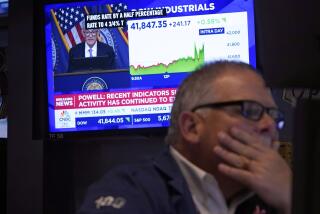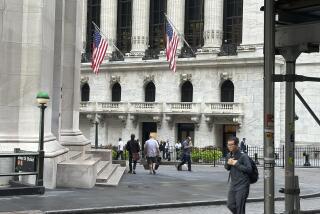Dow Plunges 35.68 in Frenzied ‘Triple Witching Hour’ Trading
- Share via
NEW YORK — The Dow Jones industrial average suffered its fourth-largest single-day decline ever Friday as traders watching technical market factors closed out first-quarter positions in an avalanche of last-minute selling.
The Dow tumbled 35.68 points to 1,768.55 on volume of 199.22 million shares, which made the day the fourth-busiest session ever. But market watchers said the Dow’s tailspin was set off by end-of-the-quarter “program trading” and insisted that the selling wave did not reflect a fundamental change of direction in the bull market.
Indeed, advancing stocks outnumbered decliners on the New York Stock Exchange by 10 to 7, and the American Stock Exchange index rose more than 3 points to a record high.
“If you consider the market to be the 30 stocks that make up the Dow index, it was down,” said Larry Wachtel, a market analyst with Prudential-Bache Securities. “But if you look at the other measures, that’s not the case. The day was just completely distorted by the program trades.”
Last-Minute Trading Wave
About 59 million shares were traded in the last 30 minutes, and the New York Stock Exchange took half an hour longer than usual to report the day’s transactions.
The Dow’s decline, the largest since the market gauge fell 39.10 points on Jan. 8, came as traders scrambled to make last-minute decisions on March contracts for stock-index futures, index options and individual stock options. The convergence of all three on Friday made the session’s final hour a “triple witching hour,” and traders had expected tumultuous activity.
The investors involved in such trading typically represent large institutions that pursue a complex strategy that weighs the value of stock-index futures and options against the value of the underlying stocks. On days such as Friday, when contract periods end, these traders usually must “unwind” their positions by buying or selling, depending on the relative prices of the stocks, futures indexes and options.
In Friday’s session, the traders sold off vast numbers of the blue-chip stocks that make up the Dow, apparently triggering a sell-off among other investors as well. Other stocks, such as those on the American Stock Exchange, rose in price as investors moved out of the blue chips, analysts said.
Not Fundamental Change
But market analysts said they expect the market to show few effects next week.
“I would say this may be, at worst, the beginning of a ritual dance of mid-course correction, but it’s not a fundamental directional change,” said Monte Gordon, chief market analyst at Dreyfus Corp. “What’s important to the market is still low inflation, low interest rates and an accommodative monetary policy.”
The Dow still stood about 5 points above its record Thursday close two hours before the end of Friday’s trading. But trading was light through most of the day as investors awaited what they knew would be a frenzied final hour.
Among the battered blue chips, Philip Morris fell 4 to 119, Merck lost 4 3/4 to 161, Minnesota Mining & Manufacturing slid 1 7/8 to 104 1/2, General Electric lost 2 3/8 to 76 and General Motors dropped 2 to 83 3/4. American Express slid 2 5/8 to 65 5/8 and IBM fell 1 1/8 to 149.
Among the winners for the day were brokerage stocks, which were apparently helped by first-day trading in the shares of the investment banking house Morgan Stanley. About 4.5 million shares of the stock were offered at $56.50 each, and the first trade was at $70 a share. In Big Board trading, Morgan Stanley closed at 71 on volume of 1.9 million shares.
Bond prices finished lower Friday and interest rates wound up little changed, the Associated Press reported.
A surprise resignation announcement from Federal Reserve Board Vice Chairman Preston Martin was seen as a victory for Paul A. Volcker, the central bank’s chairman whose name has become synonymous with inflation fighting.
Some bond prices recovered a bit after Martin said he was leaving.
Municipal Bonds Higher
Meanwhile, traders said the credit markets seemed wearied this week from earlier steep climbs.
Municipal issues wound up the week slightly higher, more than wiping out midweek losses.
In the municipal market, revenue bonds were unchanged Friday in average trading volume and general obligations rose 1/8 point in lighter trading.
In the secondary market for Treasury bonds, short-term securities were unchanged to down 1/32 point and intermediate governments were off by 1/32 point to 1/16 point. A key 20-year bond slid 9/16 point and the benchmark 30-year issue rose by 7/16 point.
More to Read
Inside the business of entertainment
The Wide Shot brings you news, analysis and insights on everything from streaming wars to production — and what it all means for the future.
You may occasionally receive promotional content from the Los Angeles Times.











